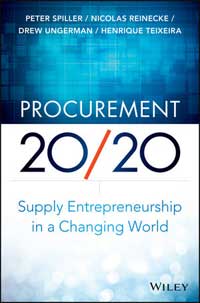From SCDigest's On-Target e-Magazine
- Jan. 16, 2014 -
Supply Chain News: New Book from McKinsey Says the Opportunities from Procurement Excellence are Huge
The Four Dimensions of Procurement Excellence
SDigest Editorial Staff
Just how big is the procurement opportunity for supply chain and overall corporate success?
Plenty big indeed, according to the new book, Procurement 20/20, written by a quartet of McKinsey analysts (Peter Spiller, Nicolas Reinecke, Drew Ungerman, and Henrique Teixeira).
SCDigest Says: |
 |
The book quotes one CEO as saying he focused on "recruiting the right people, developing the right skills, and building an appetite for real impact. Everything else came in a distant second." |
|
What Do You Say?
|
|
|
|
The book is based in large part on a substantial amount of survey work and other research the high end consulting firm has performed over the past few years, and makes a compelling case that the financial impact of being excellent at procurement is as great if not greater than any other opportunity most companies might confront.
The book starts by noting that a combination of productivity gains, outsourcing and more has led to a sharp rise in the amount that a firm spends with external parties. In 1970, external spend was 60% of total costs. In 2010, it was an amazing 85% for S&P 500 companies, a level roughly consistent across most industry sectors.
Obviously, as the percent of external spend increases, so too does the impact of being excellent or mediocre in procurement processes and practices.
The prize that can be gained from reaching procurement excellence is really worth focusing on. The authors say that based on the numerous procurement related surveys and more detailed analysis McKinsey performed with some 700 global companies, procurement leaders "not only generated higher cost savings from procurement - 30% more than average performers - they also performed better across a broad set of indicators. That includes reducing their cost of goods sold faster and achieving higher overall returns from operations."
Interestingly, the McKinsey research found that differences in procurement performance were much greater within industry sectors than between sectors - and that every single sector had companies that operated at the highest levels of procurement performance.
At the CEO and executive level, the "call to action" is clear, the authors say, and is comprised of two parts. First, procurement organizations and the chief procurement officers which lead them must raise their performance levels to those of leader comanies, which will drive significant dollars to the bottom line. Second, procurement organizations at most companies need to better leverage their supplier networks for innovation, risk reduction and more.
The book notes that compared with the level of savings and organizational improvement that procurement leadership can bring, the barriers to getting their often appear quite trivial: lack of talent in the procurement team, mediocre "governance," poor data, and IT support that is average or worse. Sometimes, the barrier may simply be the lack of CEO or CFO focus on procurement excellence, which the authors say "is a significant lapse in judgment," as the "impact achieved with good procurement far outweighs the efforts needed to overcome" these barriers.
(Sourcing and Procurement Article Continues Below)
|
 Take the lack of procurement talent, for example - a key theme of the book. The authors cite the example of global transportation company whose CEO focused for three years on just upgrading his procurement team's talent levels. They quote the CEO as saying he focused on "recruiting the right people, developing the right skills, and building an appetite for real impact. Everything else came in a distant second." Take the lack of procurement talent, for example - a key theme of the book. The authors cite the example of global transportation company whose CEO focused for three years on just upgrading his procurement team's talent levels. They quote the CEO as saying he focused on "recruiting the right people, developing the right skills, and building an appetite for real impact. Everything else came in a distant second."
The result: double digit percentage cost reductions in each of the succeeding three years.
The Four Dimensions of Procurement Excellence
McKinsey says there are four areas that companies should focus on to achieve procurement excellence and reap the substantial rewards that will come from that improvement:
Capabilities and Culture: the way that procurement professionals think, plan and conduct themselves, how they communicate individually and collectively.
Category Management and Execution: the strategies and processes the procurement organization uses to create value.
Structures and Systems: How the procurement organization manages its resources through formal and informal structures, and how it interacts with other functions.
Integration and Alignment: How connected procurement strategies and results are to the company's overall business goals.
With these as the four focus areas, McKinsey says that there are also a number of overall megatrends that procurement organizations will need to navigate. Those are:
The Great Global Rebalancing: the rapid growth of emerging markets, and the slowdown in mature economies.
The Productivity Imperative: Changing demographics and other factors in mature economies are placing a premium on process innovation.
Big Data and the Global Grid: Growing global connectivity, the "internet of things," vast, almost unimaginable stores of information and more will create big opportunities - and risk.
The Volatile New Normal: McKinsey believes there will be increasing pressure and shortages - if sometimes temporary - in many natural resources and materials, leading to greater volatility in prices and supply.
New Economic Drivers: There will continue to be increasing government regulation on a global basis, as well as new pressures from customers and consumers in areas such as sustainability and social responsibility.
With this as a backdrop, next week SCDigest will summarize the book's recommendations for achieving procurement excellence.
Any reaction to this introduction to Procurement 20/20? Let us know your thoughts at the Feedback button or section below.

|